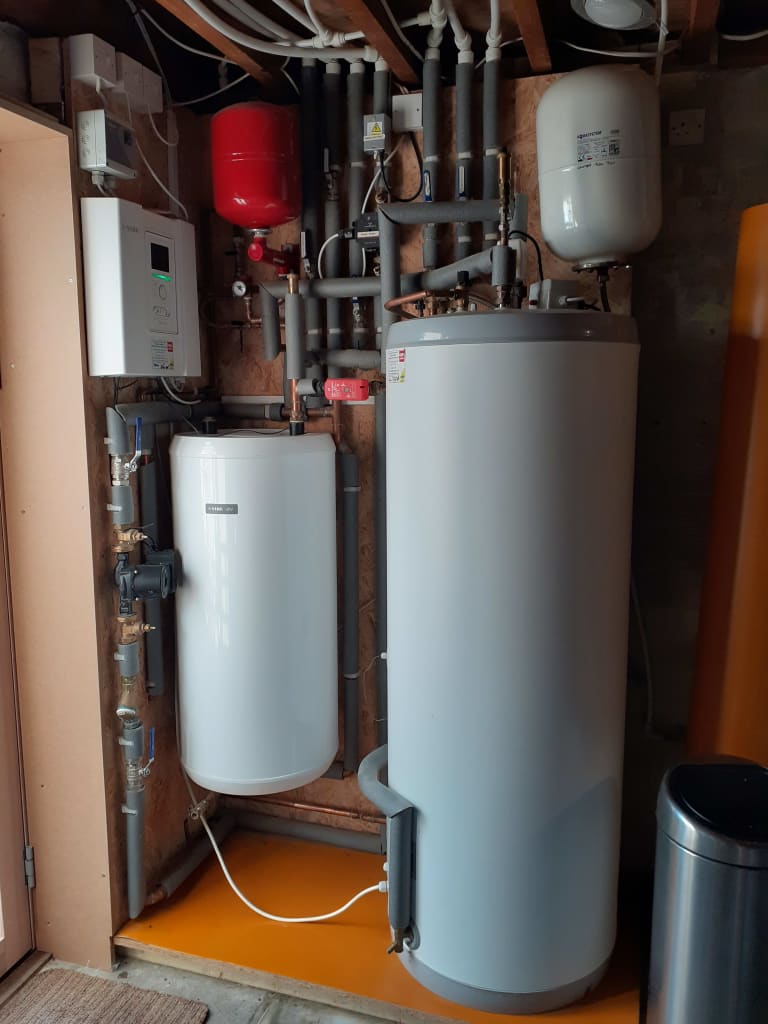Detached property, hosted by Lucy
NIBE air source heat pump in a 1945 - 1964 property
Lucy
About me
We bought our 1960s house in 2018 but it was two years later (thanks to Covid) before we found the time to carry out all the work we wanted to do. My husband, an architect, and I were keen to do all we could to make the house as green as possible, including replacing the old gas boiler with an air-source heat pump (ASHP).
Visiting my heat pump
We welcome visitors. We can accommodate most days/times except Tuesdays and Wednesdays.
Joined the network in 2025
Upcoming events
This host doesn't have an upcoming event at the moment.
You can still message them to ask if you can visit or to ask questions about their experience.
Message meAbout this property
Orpington, BR6
4 bedrooms
Air source heat pump
Installed by Bushby Heating
EPC rating: B
Cost of energy bills per year: £1500
Installing the system
· 65mm insulated plasterboard to the inside of all the external walls
· triple glazed Norrsken windows and external doors
· 14 x Perlight PV (solar) panels and a Solax X1 Phase Inverter
· floor insulation, and underfloor heating, in the new extension
· roof insulation (100mm mineral wool between rafters and 50mm insulated plasterboard)
· new Stelrad radiators and pipes
· an induction hob (meaning we no longer use gas at all in the house)
· new wiring throughout and two new consumer units (fuse boards) – the ASHP requires two high-rated feeds from the consumer unit
All this was done to make the house energy efficient, without which the ASHP would not be sustainable, financially or environmentally. The house had an energy efficiency rating of E (47 points) when we bought it. When we’d finished it had a new EPC rating B, with 82 points (it’s almost impossible to get A, unless you have a new passive house).
The house is generously sized, so we could afford to lose some space to the wall insulation (about 70mm) and had space to house all the tanks and pipework needed with the ASHP. The only bit we couldn’t insulate was the solid floor in the existing ground floor; we would’ve had to rip up the beautiful original parquet.
With an ASHP you need more surface area to radiate heat than with water heated from a gas boiler. You don’t necessarily need new radiators but ideally you need large/vertical or triple radiators. The best surface area is of course the floor, but underfloor heating can limit your floor covering choices.
The build was not without its difficulties: we were without heating or hot water for 5 months over winter because we had to remove our water tank before we were ready; we all got Covid (from school) and had to shut the site down; our guttering arrived very late, thanks to Brexit-related import issues.
We have an NIBE F2040 12KW heat pump, which generates all our heating and hot water. Our annual space heating demand was calculated at 26450 kWh, and the hot water at 4495kWh (we are 4 people in a 4-bed, detached house). Obviously requirements will be different for each family and building.
I did not realise how much space an ASHP would take up, both inside and out. The outside unit is about 1m high by 1m wide and you need a space at least 1m deep to accommodate it comfortably. It sits on a concrete plinth – ideally you need it located so that the pipes go directly from the pump to the hot water tank in the shortest distance. The hot water tank needed for an ASHP is larger than that for a gas boiler. Ours is 300l.
The heat pump works by generating a low heat for long periods; rather than having radiators blasting a high heat for a few hours each day they give off a gentle heat throughout the day. Our heat pump measures the external temperature and turns on when it’s cold outside, rather than being controlled by a thermostat, although you can also add thermostats to the control system for additional control.
Similarly, the water is heated to a pleasant 45C, as opposed to a gas boiler that often heats the water to 60C (hotter than is generally needed so cold has to then be added). There’s a booster setting on the ASHP to take the water temperature over 60C every seven days, to prevent Legionnaires.
Living with a heat pump
Overall we're very happy with the ASHP so far and have not had any problems. There's lots of settings to play with, it takes a while to get it working at its most efficient for your comfort levels. The house is comfortably warm in winter; the subtle heating is much better for my excema as it doesn't dry my skin, but may not suit those who like it super hot and toasty.
I hope we inspire some of you to explore the viability of an ASHP in your home. Any questions please ask!
Hosted by Lucy
Follow this property to make sure you get emailed about their next event.
Follow this propertyAccessing the venue
Free on street parking. One step to enter the house.
